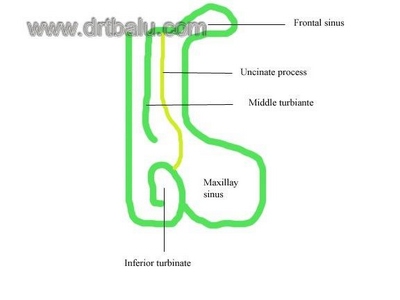Uncinate process
The uncinate process is a wing or boomerang shaped piece of bone. It forms the first layer or lamella of the middle meatus. It attache santeriorly to the posterior edge of the lacrimal bone, and inferiorly to the superior edge of the inferior turbinate. Superior attachment of the uncinate process is highly variable, may be attached to the lamina papyracea, or the roof of the ethmoidal sinus, or sometimes to the middle turbinate. The configuration of the ethmoidal infundibulum and its relationship to the frontal recessd epends largely on the behaviour of the uncinate process. Theuncinate process can be classified into 3 types depending on its superior attachment. The anterior insertion of the uncinate processcannot be identified clearly because it is covered with mucosa whichis continuous with that of the lateral nasal wall. Sometimes a smallgroove is visible over the area where the uncinate attaches itself to the lateral nasal wall.
Type I uncinate: Here the uncinate process bends laterally in its upper most portion andinserts into the lamina papyracea. Here the ethmoidal infundibulum is closed superiorly by a blind pouch called the recessus terminalis (terminal recess). In this case the ethmoidal infundibulum and the frontal recess are separated from each other so that the frontal recess opens in to the middle meatus medial to the ethmoidal infundibulum, betweenthe uncinate process and the middle turbinate. The route of drainageand ventilation of the frontal sinus run medial to the ethmoidalinfundibulum.
Type II uncinate: Here the uncinate process extends superiorly to the roof of the ethmoid. The frontal sinus opens directly into the ethmoidal infundibulum. In these cases a disease in the frontal recess may spread to involve theethmoidal infundibulum and the maxillary sinus secondarily. Sometimes the superior end of the uncinate process may get divided into three branches one getting attached to the roof of the ethmoid, one getting attached to the lamina papyracea, and the last getting attached to the middle turbinate.
Type III uncinateprocess: In this type the superior end of the uncinate process turnsmedially to get attached to the middle turbinate. Here also the frontal sinus drains directly into the ethmoidal infundibulum.
Uncinate process should be removed in all endoscopic sinus surgical procedures inorder to open up the middle meatus. In fact this is the first step in endoscopic sinus surgery.
Rarely the uncinate process itself may be heavily pneumatised causingobstructionto the infundibulum.


